目录
2.2 创建Controller类并在Controller的方法上加入注解进行权限控制
一、摘要
Spring Security除了可以在配置文件中配置权限校验规则,还可以使用注解方式控制类 中方法的调用。例如Controller中的某个方法要求必须具有某个权限才可以访问,此时就 可以使用Spring Security框架提供的注解方式进行控制。
二、实现步骤:
2.1 在配置类中添加权限注解的支持
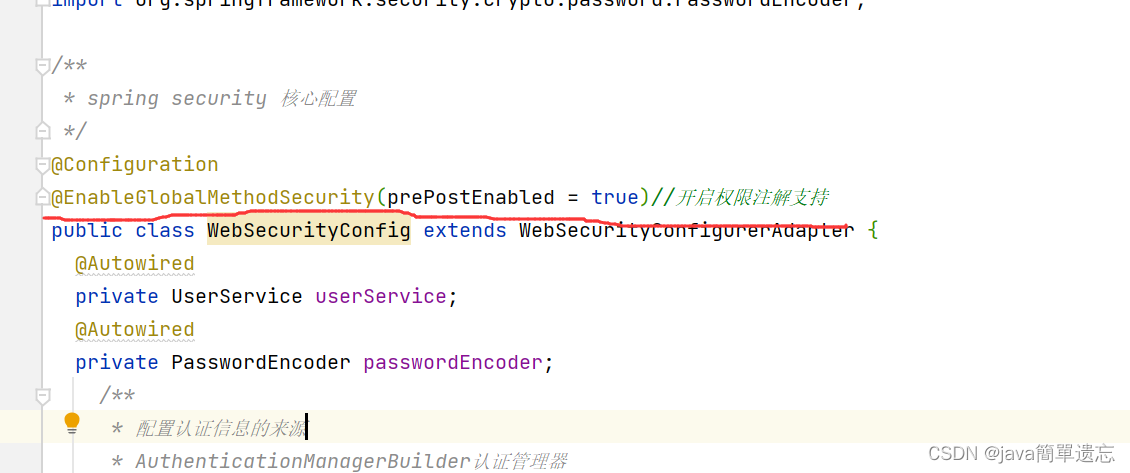
package com.by.config;
//import com.by.service.UserService;
import com.by.service.UserService;
import org.springframework.beans.factory.annotation.Autowired;
import org.springframework.context.annotation.Bean;
import org.springframework.context.annotation.Configuration;
import org.springframework.security.config.annotation.authentication.builders.AuthenticationManagerBuilder;
import org.springframework.security.config.annotation.method.configuration.EnableGlobalMethodSecurity;
import org.springframework.security.config.annotation.web.builders.HttpSecurity;
import org.springframework.security.config.annotation.web.builders.WebSecurity;
import org.springframework.security.config.annotation.web.configuration.WebSecurityConfigurerAdapter;
import org.springframework.security.crypto.bcrypt.BCryptPasswordEncoder;
import org.springframework.security.crypto.password.PasswordEncoder;
/**
* spring security 核心配置
*/
@Configuration
@EnableGlobalMethodSecurity(prePostEnabled = true)//开启权限注解支持
public class WebSecurityConfig extends WebSecurityConfigurerAdapter {
@Autowired
private UserService userService;
@Autowired
private PasswordEncoder passwordEncoder;
/**
* 配置认证信息的来源
* AuthenticationManagerBuilder认证管理器
*/
@Override
protected void configure(AuthenticationManagerBuilder auth) throws Exception {
// 配置认证提供者
auth.userDetailsService(userService).passwordEncoder(passwordEncoder);//配置认证提供者
super.configure(auth);//密码
}
/**
* 配置web的安全(忽略的静态资源)
*
* @param web
* @throws Exception
*/
@Override
public void configure(WebSecurity web) throws Exception {
//web.ignoring().antMatchers("/pages/a.html","/pages/b.html");
//web.ignoring().antMatchers("/pages/**");
//指定login.html页面可以匿名访问
web.ignoring().antMatchers("/login.html");
}
/**
* 配置HTTP请求的安全(认证、授权、退出)
* HttpSecurity 用于构建一个安全过滤器链 SecurityFilterChain
*
* @param http
* @throws Exception
*/
@Override
protected void configure(HttpSecurity http) throws Exception {
// super.configure(http);
http.formLogin()
.loginPage("/login.html")// 默认页面
.loginProcessingUrl("/login")//请求
.usernameParameter("username")
.passwordParameter("password")
// 请求成功后访问哪个路径
.defaultSuccessUrl("/index.html",true);
//权限配置
http.authorizeRequests()
//.antMatchers("pages/a.html").authenticated()
.antMatchers("/pages/b.html").hasAuthority("add")
/**
* 拥有ROLE_ADMIN可以访问d页面
* 注意:此处虽然写的是ADMIN,但是框架会自动添加前缀ROLE_
*/
.antMatchers("pages/c.html").hasRole("ADMIN")
// 其他资源均需要登录后访问
.anyRequest().authenticated();
// super.configure(http);
//关闭跨站请求防护
http.csrf().disable();
}
/**
* 配置加密对象
* @return
*/
@Bean
public PasswordEncoder passwordEncoder(){
return new BCryptPasswordEncoder();
}
}
2.2 创建Controller类并在Controller的方法上加入注解进行权限控制
package com.by.controller;
import org.springframework.security.access.prepost.PreAuthorize;
import org.springframework.web.bind.annotation.RequestMapping;
import org.springframework.web.bind.annotation.RestController;
@RestController
@RequestMapping("/hello")
public class HelloController {
@RequestMapping("/add")
/**
* 表示用户要拥有add权限 才能访问该方法
*/
@PreAuthorize("hasAuthority('add')")
public String add(){
System.out.println("add");
return "success";
}
}
2.3 UserService类
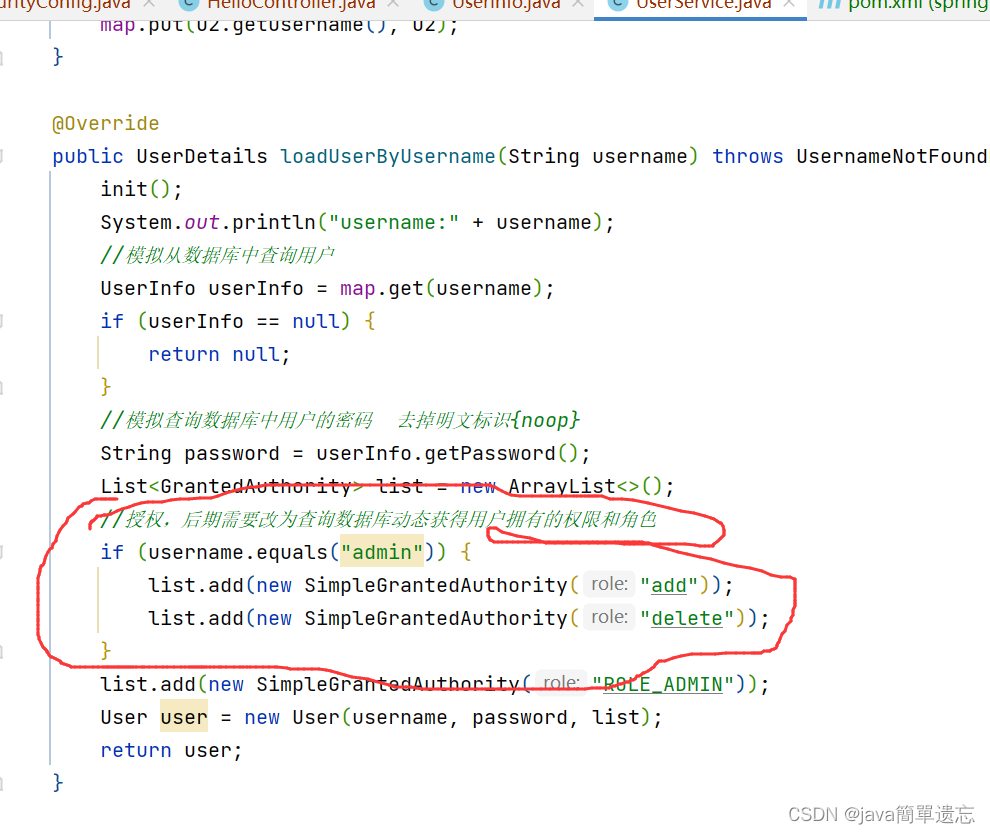
package com.by.service;
import com.by.pojo.UserInfo;
import org.springframework.beans.factory.annotation.Autowired;
import org.springframework.security.core.GrantedAuthority;
import org.springframework.security.core.authority.SimpleGrantedAuthority;
import org.springframework.security.core.userdetails.User;
import org.springframework.security.core.userdetails.UserDetails;
import org.springframework.security.core.userdetails.UserDetailsService;
import org.springframework.security.core.userdetails.UsernameNotFoundException;
import org.springframework.security.crypto.bcrypt.BCryptPasswordEncoder;
import org.springframework.security.crypto.password.PasswordEncoder;
import org.springframework.stereotype.Component;
import java.util.ArrayList;
import java.util.HashMap;
import java.util.List;
import java.util.Map;
@Component
public class UserService implements UserDetailsService {
@Autowired
private PasswordEncoder passwordEncoder;
//模拟向数据库中插入数据
public Map<String, UserInfo> map = new HashMap<>();
public void init() {
UserInfo u1 = new UserInfo();
u1.setUsername("admin");
u1.setPassword(passwordEncoder.encode("123"));
UserInfo u2 = new UserInfo();
u2.setUsername("user");
u2.setPassword(passwordEncoder.encode("123"));
map.put(u1.getUsername(), u1);
map.put(u2.getUsername(), u2);
}
@Override
public UserDetails loadUserByUsername(String username) throws UsernameNotFoundException {
init();
System.out.println("username:" + username);
//模拟从数据库中查询用户
UserInfo userInfo = map.get(username);
if (userInfo == null) {
return null;
}
//模拟查询数据库中用户的密码 去掉明文标识{noop}
String password = userInfo.getPassword();
List<GrantedAuthority> list = new ArrayList<>();
//授权,后期需要改为查询数据库动态获得用户拥有的权限和角色
if (username.equals("admin")) {
list.add(new SimpleGrantedAuthority("add"));
list.add(new SimpleGrantedAuthority("delete"));
}
list.add(new SimpleGrantedAuthority("ROLE_ADMIN"));
User user = new User(username, password, list);
return user;
}
public static void main(String[] args) {
for (int i = 0; i < 3; i++) {
String password="123456";
/**
* BCryptPasswordEncoder是Spring Security
* 提供的一个加密的API
*/
BCryptPasswordEncoder bCryptPasswordEncoder = new BCryptPasswordEncoder();
String hashPassWord = bCryptPasswordEncoder.encode(password);
System.out.println(hashPassWord);
boolean flag = bCryptPasswordEncoder.matches("123456", hashPassWord);
System.out.println(flag);
}
}
}
三、测试
可以看出admin有add方法的访问权限,而user则没有add方法的访问权限
3.1 user测试

3.2 admin 测试
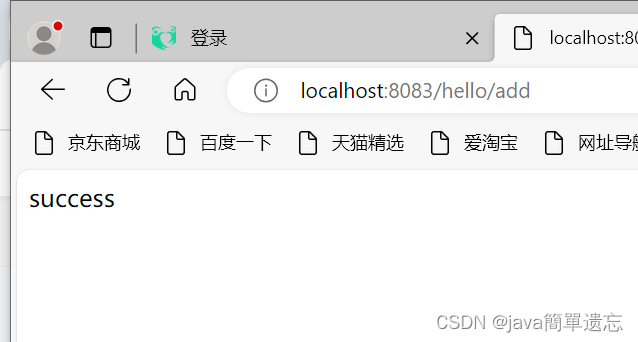
四、退出登录功能
用户完成登录后Spring Security框架会记录当前用户认证状态为已认证状态,即表示用 户登录成功了。那用户如何退出登录呢?我们可以配置类中进行如下 配置:
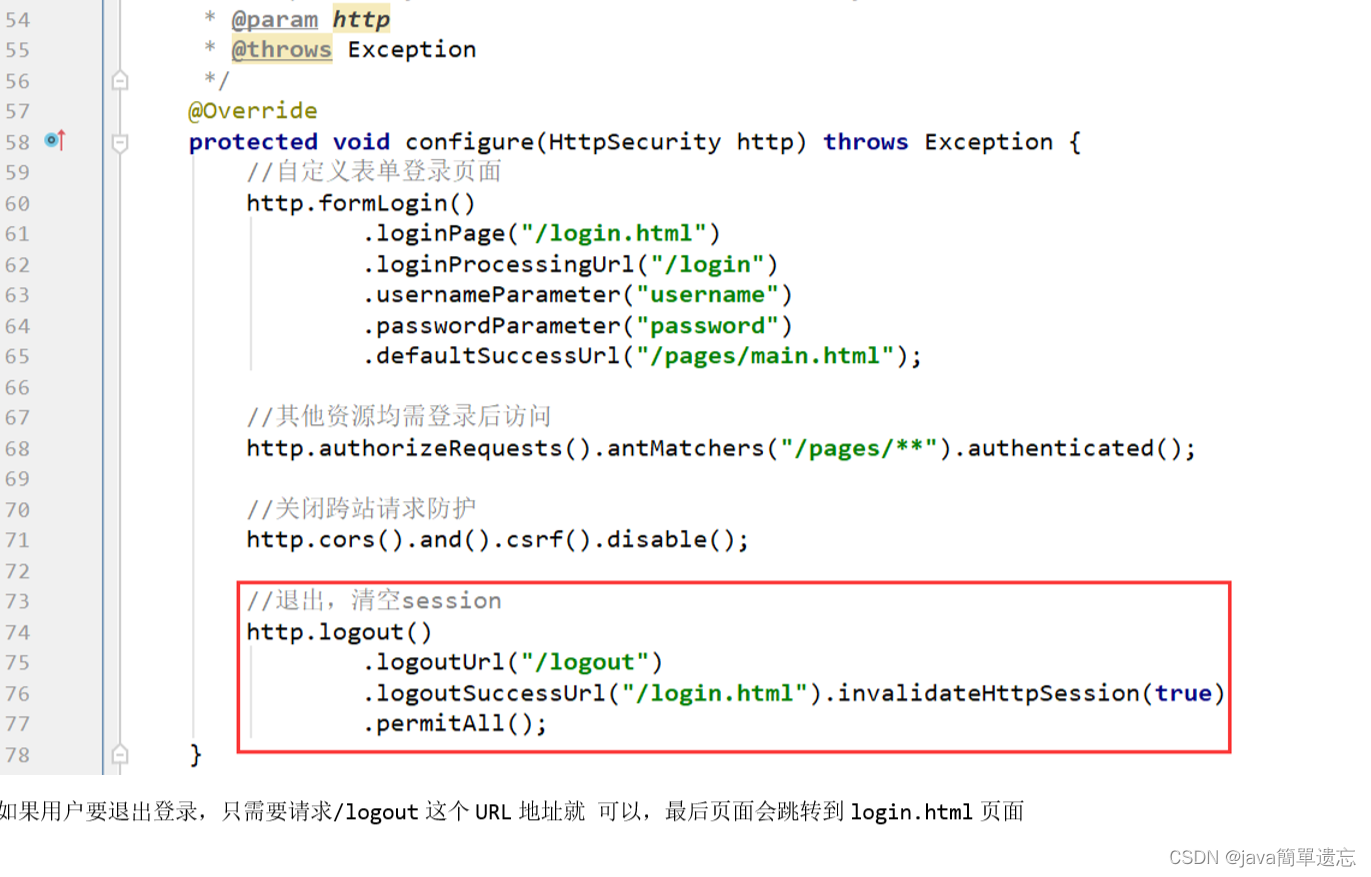
package com.by.config;
//import com.by.service.UserService;
import com.by.service.UserService;
import org.springframework.beans.factory.annotation.Autowired;
import org.springframework.context.annotation.Bean;
import org.springframework.context.annotation.Configuration;
import org.springframework.security.config.annotation.authentication.builders.AuthenticationManagerBuilder;
import org.springframework.security.config.annotation.method.configuration.EnableGlobalMethodSecurity;
import org.springframework.security.config.annotation.web.builders.HttpSecurity;
import org.springframework.security.config.annotation.web.builders.WebSecurity;
import org.springframework.security.config.annotation.web.configuration.WebSecurityConfigurerAdapter;
import org.springframework.security.crypto.bcrypt.BCryptPasswordEncoder;
import org.springframework.security.crypto.password.PasswordEncoder;
/**
* spring security 核心配置
*/
@Configuration
@EnableGlobalMethodSecurity(prePostEnabled = true)//开启权限注解支持
public class WebSecurityConfig extends WebSecurityConfigurerAdapter {
@Autowired
private UserService userService;
@Autowired
private PasswordEncoder passwordEncoder;
/**
* 配置认证信息的来源
* AuthenticationManagerBuilder认证管理器
*/
@Override
protected void configure(AuthenticationManagerBuilder auth) throws Exception {
// 配置认证提供者
auth.userDetailsService(userService).passwordEncoder(passwordEncoder);//配置认证提供者
super.configure(auth);//密码
}
/**
* 配置web的安全(忽略的静态资源)
*
* @param web
* @throws Exception
*/
@Override
public void configure(WebSecurity web) throws Exception {
//web.ignoring().antMatchers("/pages/a.html","/pages/b.html");
//web.ignoring().antMatchers("/pages/**");
//指定login.html页面可以匿名访问
web.ignoring().antMatchers("/login.html");
}
/**
* 配置HTTP请求的安全(认证、授权、退出)
* HttpSecurity 用于构建一个安全过滤器链 SecurityFilterChain
*
* @param http
* @throws Exception
*/
@Override
protected void configure(HttpSecurity http) throws Exception {
// super.configure(http);
http.formLogin()
.loginPage("/login.html")// 默认页面
.loginProcessingUrl("/login")//请求
.usernameParameter("username")
.passwordParameter("password")
// 请求成功后访问哪个路径
.defaultSuccessUrl("/index.html",true);
//权限配置
http.authorizeRequests()
//.antMatchers("pages/a.html").authenticated()
.antMatchers("/pages/b.html").hasAuthority("add")
/**
* 拥有ROLE_ADMIN可以访问d页面
* 注意:此处虽然写的是ADMIN,但是框架会自动添加前缀ROLE_
*/
.antMatchers("pages/c.html").hasRole("ADMIN")
// 其他资源均需要登录后访问
.anyRequest().authenticated();
/**
* 退出登录
*/
http.logout()
.logoutUrl("/logout")
.logoutSuccessUrl("/login.html").invalidateHttpSession(true);
// super.configure(http);
//关闭跨站请求防护
http.csrf().disable();
}
/**
* 配置加密对象
* @return
*/
@Bean
public PasswordEncoder passwordEncoder(){
return new BCryptPasswordEncoder();
}
}
在a.html 设置一个退出登录的超链接
<!DOCTYPE html>
<html lang="en">
<head>
<meta charset="UTF-8">
<title>Title</title>
</head>
<body>
我是b.html
<a href="/logout">退出登录</a>
</body>
</html>测试
登录后访问localhost:8083/pages/a.html 然后点击退出登录。
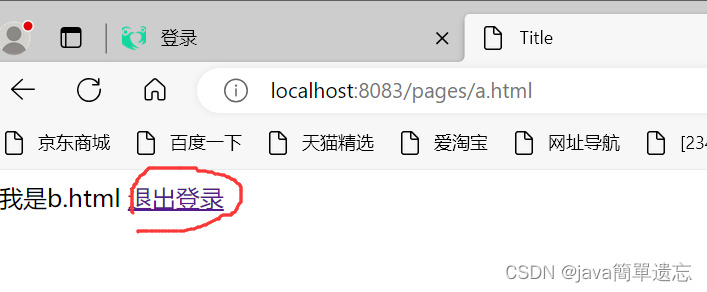
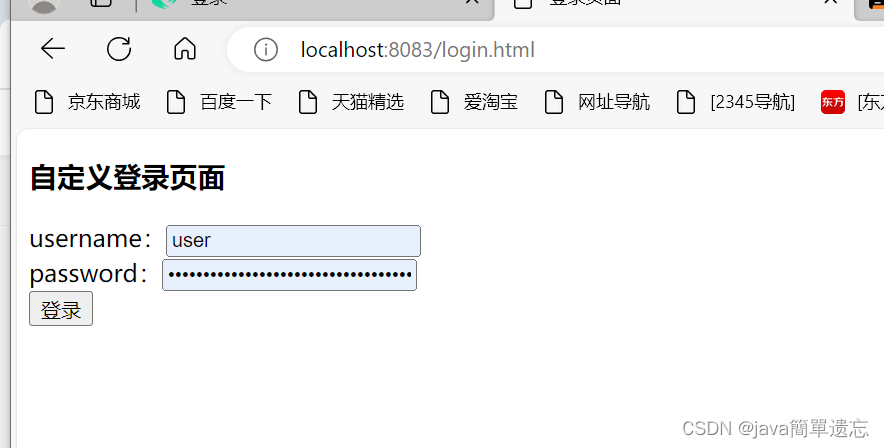 如果用户要退出登录,只需要请求/logout这个URL地址就 可以,最后页面会跳转到login.html页面
如果用户要退出登录,只需要请求/logout这个URL地址就 可以,最后页面会跳转到login.html页面








 本文详细介绍了如何在SpringSecurity中使用注解方式控制Controller方法权限,包括配置认证、权限规则和退出登录功能,通过例子展示了如何在UserService和Controller类中应用@PreAuthorize注解实现权限管理。
本文详细介绍了如何在SpringSecurity中使用注解方式控制Controller方法权限,包括配置认证、权限规则和退出登录功能,通过例子展示了如何在UserService和Controller类中应用@PreAuthorize注解实现权限管理。















 1186
1186











 被折叠的 条评论
为什么被折叠?
被折叠的 条评论
为什么被折叠?










